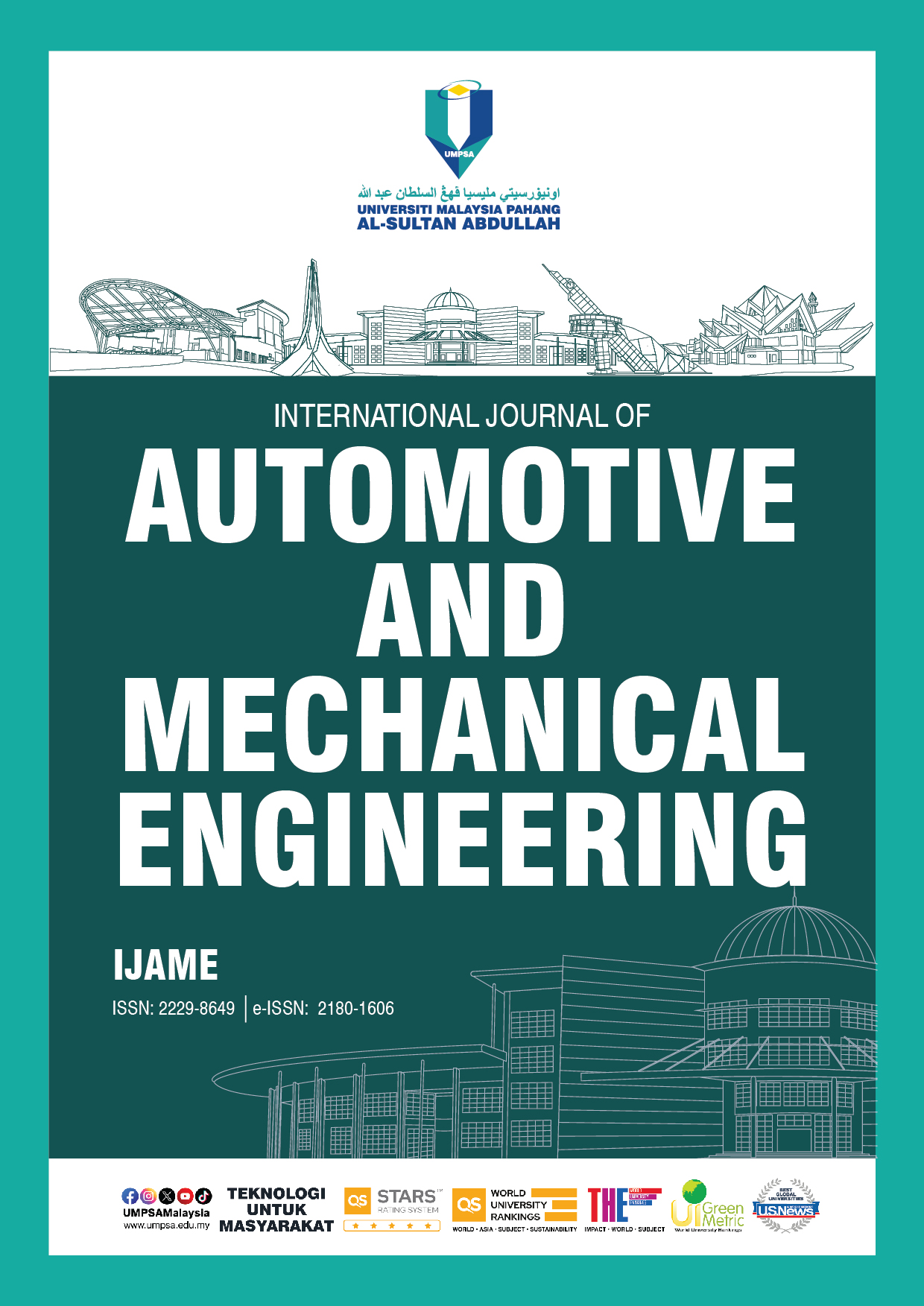Driving into the Dynamics-Leveraging the Direct-Quadrature-Zero Transform for Mechanical Systems
DOI:
https://doi.org/10.15282/ijame.22.1.2025.19.0936Keywords:
Dynamic analysis, DQ coordinates, Multi-DOF systems, Mechanical system, DynamicsAbstract
This research offers a thorough analysis of the dynamic behavior of 1-, 2-, and 3-degrees-of-freedom (DoF) mechanical systems under a sinusoidal force, examining both mechanical and dq coordinates. By utilizing standardized initial conditions, the 1-DoF system displays fascinating oscillatory patterns with dual frequency components, highlighting the significance of low damping. The adaptation to dq coordinates simplifies the analysis and highlights the system's nuanced behavior. In contrast, the 2-DoF system exhibits intricate interactions, oscillation phenomena, and multiple frequency components in mechanical coordinates. The contribution of masses that do not experience external forces in dq coordinates is minimal. On the other hand, the 3-DoF system shows diverse interactions and frequency components that are different from the dq transformations. The observed dynamics not only enhance comprehension of these systems but also provide valuable insights for refining analytical approaches in the analysis of dynamic systems. This study sets the stage for future investigations and urges the development of streamlined analytical frameworks for a more focused exploration of externally influenced variables in dynamic mechanical systems.
References
[1] D. Findeisen, System Dynamics and Mechanical Vibrations: An Introduction. Springer Berlin, Heidelberg, 2010.
[2] R. Arias, A. P. da Cunha, and A. R. Garcia Ramirez, “Teaching of mechanical vibration concepts using the computational simulation,” IEEE Latin America Transactions, vol. 18, no. 4, pp. 659–667, 2020.
[3] E. A. Burda, G. V. Zusman, I. S. Kudryavtseva, and A. P. Naumenko, “An overview of vibration analysis techniques for the fault diagnostics of rolling bearings in machinery,” Shock and Vibration, vol. 2022, p. e6136231, 2022.
[4] H. P. Bloch and F. K. Geitner, Eds., “Chapter 5 - Vibration Analysis,” in Practical Machinery Management for Process Plants, vol. 2, Gulf Professional Publishing, 1999, pp. 351–433.
[5] B. Yang, “Chapter 10 - Vibration analysis of one-degree-of-freedom systems,” in Stress, Strain, and Structural Dynamics (Second Edition), B. Yang, Ed. Academic Press, 2023, pp. 431–528.
[6] F. Svaricek, C. Bohn, P. Marienfeld, H.-J. Karkosch, T. Fueger, F. Svaricek, C. Bohn, P. Marienfeld, H.-J. Karkosch, and T. Fueger, “Automotive Applications of Active Vibration Control,” in Vibration Control, IntechOpen, 2010.
[7] O. I. Vulcu and M. Arghir, “Impact of maintenance in the automotive field. Experimental study of mechanical vibration,” IOP Conference Series: Materials Science and Engineering, vol. 147, no. 1, p. 012056, 2016.
[8] Z. You, “Design of automotive mechanical automatic transmission system based on torsional vibration reduction,” Journal of Vibroengineering, vol. 25, no. 4, pp. 683–697, 2023.
[9] M. Bonato and P. Goge, “Methods for analysis and comparison of automotive vibration tests,” in 2016 Annual Reliability and Maintainability Symposium (RAMS), pp. 1–6, 2016.
[10] K. C. Panda, “Dealing with noise and vibration in automotive industry,” Procedia Engineering, vol. 144, pp. 1167–1174, 2016.
[11] S. Jiang, H. Liu, Z. Gu, and Q. Liu, “Mechanical simulation analysis of aerospace high reliability electronic equipment,” Journal of Physics: Conference Series, vol. 2187, no. 1, p. 012035, 2022.
[12] L. Liu and B. Tian, “Comprehensive engineering frequency domain analysis and vibration suppression of flexible aircraft based on active disturbance rejection controller,” Sensors, vol. 22, no. 16, p. 6207, 2022.
[13] B. A and S. Zolkiewski, “Dynamic analysis of the mechanical systems vibrating transversally in transportation,” Journal of Achievements in Materials and Manufacturing Engineering, vol. 20, 2007.
[14] W. Wang, G. Shen, Y. Zhang, Z. Zhu, C. Li, and H. Lu, “Dynamic reliability analysis of mechanical system with wear and vibration failure modes,” Mechanism and Machine Theory, vol. 163, p. 104385, 2021.
[15] K. Kamei and M. A. Khan, “Current challenges in modelling vibrational fatigue and fracture of structures: a review,” Journal of the Brazilian Society of Mechanical Sciences and Engineering, vol. 43, no. 2, p. 77, 2021.
[16] M. Romanssini, P. C. C. de Aguirre, L. Compassi-Severo, and A. G. Girardi, “A review on vibration monitoring techniques for predictive maintenance of rotating machinery,” Eng, vol. 4, no. 3, pp. 1797–1817, 2023.
[17] D. Y. Ou and C. M. Mak, “A review of prediction methods for the transient vibration and sound radiation of plates,” Journal of Low Frequency Noise, Vibration and Active Control, vol. 32, no. 4, pp. 309–322, 2013.
[18] N. Anh and N. Nguyen, “Design of non-traditional dynamic vibration absorber for damped linear structures,” Proceedings of the Institution of Mechanical Engineers, Part C: Journal of Mechanical Engineering Science, vol. 228, no. 1, pp. 45–55, 2014.
[19] M. H. Mohd Ghazali and W. Rahiman, “Vibration analysis for machine monitoring and diagnosis: A systematic review,” Shock and Vibration, vol. 2021, p. e9469318, 2021.
[20] S. Saxena and M. Patel, “Evaluating dynamic behaviour of a concrete dam using modal analysis,” Materials Today: Proceedings, vol. 93, pp. 296-301, 2023.
[21] H. Van der Auweraer, “Structural dynamics modeling using modal analysis: applications, trends and challenges,” in IMTC 2001. Proceedings of the 18th IEEE Instrumentation and Measurement Technology Conference. Rediscovering Measurement in the Age of Informatics (Cat. No.01CH 37188), vol. 3, pp. 1502–1509, 2001.
[22] K. Ogata, Modern Control Engineering, 5th edition. Boston: Pearson, 2009.
[23] B. C. Kuo, Automatic control systems, 6th edition. Englewood Cliffs, N.J: Prentice Hall, 1991.
[24] W. S. Levine, The Control Handbook (three volume set). CRC Press, 2018.
[25] C. J. O’Rourke, M. M. Qasim, M. R. Overlin, and J. L. Kirtley Jr, “A Geometric Interpretation of Reference Frames and Transformations: dq0, Clarke, and Park,” Colm O’Rourke, 2019.
[26] M. Gonzalez, V. Cardenas, and F. Pazos, “DQ transformation development for single-phase systems to compensate harmonic distortion and reactive power,” in 9th IEEE International Power Electronics Congress, 2004. CIEP 2004, pp. 177–182, 2004.
[27] M. F. Schonardie and D. C. Martins, “Application of the dq0 transformation in the three-phase grid-connected PV systems with active and reactive power control,” in 2008 IEEE International Conference on Sustainable Energy Technologies, pp. 18–23, 2008.
[28] K. S. Low, M. F. Rahman, and K. W. Lim, “The dq transformation and feedback linearization of a permanent magnet synchronous motor,” in Proceedings of 1995 International Conference on Power Electronics and Drive Systems. PEDS 95, pp. 292–296 vol.1, 1995.
[29] S. W. L. Tobing, R. Afdila, P. E. Panjaitan, N. C. Situmeang, K. N. Hutagalung, and R. Sidabutar, “ABC to DQ Transformation for Three-Phase Inverter Design as Prime Mover Speed Control in Microgrid System,” in 2022 6th International Conference on Electrical, Telecommunication and Computer Engineering (ELTICOM), pp. 70–74, 2022.
[30] M. F. Schonardie, R. F. Coelho, R. Schweitzer, and D. C. Martins, “Control of the active and reactive power using dq0 transformation in a three-phase grid-connected PV system,” in 2012 IEEE International Symposium on Industrial Electronics, pp. 264–269, 2012.
[31] K. Abe, The Clark and Park transformations: Coordinate transformations for Brushless DC motor in field-oriented control. 2017.
[32] J. Campos Salazar, A. Viani-Abad, and R. Sandoval-García, “Modeling and Simulation of a Single-Phase Linear Multi-Winding Transformer in the d-q Frame,” Journal of Electronics and Electrical Engineering, vol. 3, pp. 206–235, 2024.
[33] B. C. Trento, “Modeling and Control of Single Phase Grid-Tie Converters,” Masters Theses, 2012.
[34] A. C. J. Luo, Nonlinear Deformable-body Dynamics, 2010th edition. Beijing : Berlin ; New York: Springer Verlag, 2010.
[35] A. W. Pila, Introduction To Lagrangian Dynamics, 1st ed. 2020 edition. Cham, Switzerland: Springer, 2019.
[36] G. A. Anastassiou and I. F. Iatan, “Linear Transformations,” in Intelligent Routines II: Solving Linear Algebra and Differential Geometry with Sage, G. A. Anastassiou and I. F. Iatan, Eds. Cham: Springer International Publishing, 2014, pp. 91–134.
[37] W. Hauser, Introduction to the Principles of Mechanics. Addison-Wesley Publishing Company, 1965.
[38] B. Porter and R. Crossley, Modal Control: Theory and Applications, 0 edition. London: Taylor & Francis, 1972.
[39] K. Peleg, “Power and energy in mechanical systems,” International Journal of Mechanical Sciences, vol. 29, no. 4, pp. 259–269, 1987.
[40] B. V. Malozyomov, N. V. Martyushev, S. N. Sorokova, E. A. Efremenkov, and M. Qi, “Mathematical modeling of mechanical forces and power balance in electromechanical energy converter,” Mathematics, vol. 11, no. 10, p. 2394, 2023.
[41] M. R. Spiegel, Spiegel: Applied Differential Equations. Prentice-Hall, 1958.
[42] F. Ayres, Schaum’s Outline of Theory and Problems of Differential Equations. McGraw-Hill, 1967.
[43] W. H. Hayt, J. E. Kemmerly, S. Durbin, and S. M. Durbin, Engineering Circuit Analysis, McGraw-Hill, 2001.
[44] W. W. Seto, Theory and problems of mechanical vibrations:, First Edition. McGraw-Hill, 1964.
[45] W. W. Seto, Theory and Problems of Acoustics, First Edition, McGraw-Hill, 1971.
Downloads
Published
Issue
Section
License
Copyright (c) 2025 The Author(s)

This work is licensed under a Creative Commons Attribution-NonCommercial 4.0 International License.







